CHEVROLET CAMARO SS 2010 Owners Manual
Manufacturer: CHEVROLET, Model Year: 2010, Model line: CAMARO SS, Model: CHEVROLET CAMARO SS 2010Pages: 372, PDF Size: 1.91 MB
Page 301 of 372
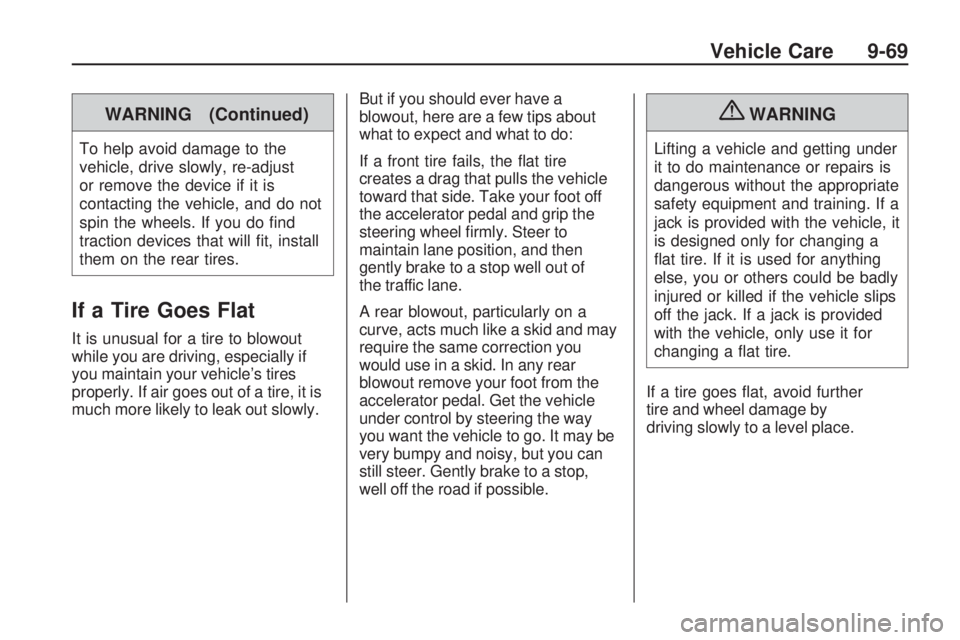
WARNING (Continued)
To help avoid damage to the
vehicle, drive slowly, re-adjust
or remove the device if it is
contacting the vehicle, and do not
spin the wheels. If you do find
traction devices that will fit, install
them on the rear tires.
If a Tire Goes Flat
It is unusual for a tire to blowout
while you are driving, especially if
you maintain your vehicle’s tires
properly. If air goes out of a tire, it is
much more likely to leak out slowly.But if you should ever have a
blowout, here are a few tips about
what to expect and what to do:
If a front tire fails, the flat tire
creates a drag that pulls the vehicle
toward that side. Take your foot off
the accelerator pedal and grip the
steering wheel firmly. Steer to
maintain lane position, and then
gently brake to a stop well out of
the traffic lane.
A rear blowout, particularly on a
curve, acts much like a skid and may
require the same correction you
would use in a skid. In any rear
blowout remove your foot from the
accelerator pedal. Get the vehicle
under control by steering the way
you want the vehicle to go. It may be
very bumpy and noisy, but you can
still steer. Gently brake to a stop,
well off the road if possible.
{WARNING
Lifting a vehicle and getting under
it to do maintenance or repairs is
dangerous without the appropriate
safety equipment and training. If a
jack is provided with the vehicle, it
is designed only for changing a
flat tire. If it is used for anything
else, you or others could be badly
injured or killed if the vehicle slips
off the jack. If a jack is provided
with the vehicle, only use it for
changing a flat tire.
If a tire goes flat, avoid further
tire and wheel damage by
driving slowly to a level place.
Vehicle Care 9-69
Page 302 of 372
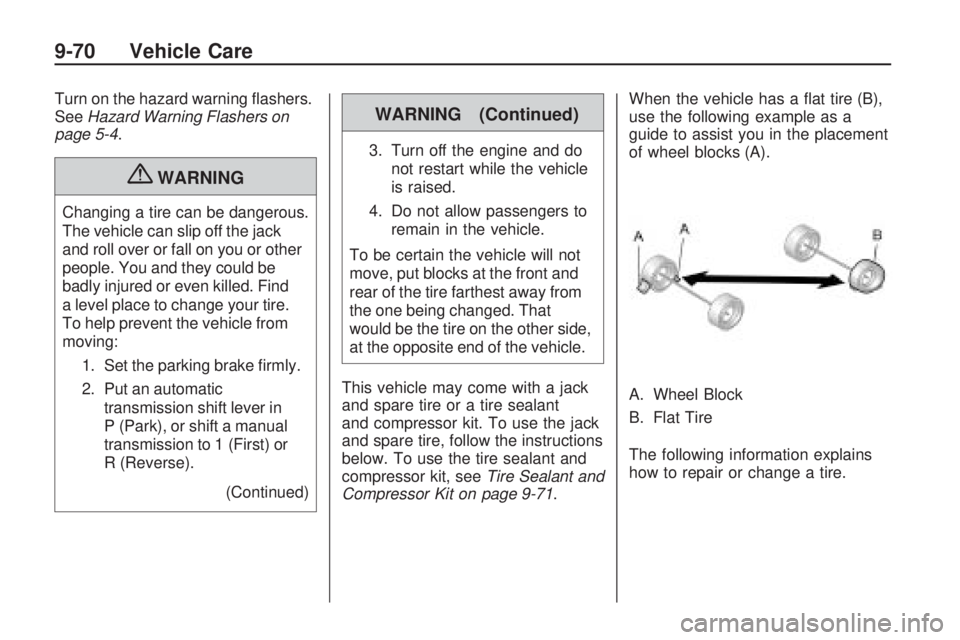
Turn on the hazard warning flashers.
SeeHazard Warning Flashers on
page 5-4.
{WARNING
Changing a tire can be dangerous.
The vehicle can slip off the jack
and roll over or fall on you or other
people. You and they could be
badly injured or even killed. Find
a level place to change your tire.
To help prevent the vehicle from
moving:
1. Set the parking brake firmly.
2. Put an automatic
transmission shift lever in
P (Park), or shift a manual
transmission to 1 (First) or
R (Reverse).
(Continued)
WARNING (Continued)
3. Turn off the engine and do
not restart while the vehicle
is raised.
4. Do not allow passengers to
remain in the vehicle.
To be certain the vehicle will not
move, put blocks at the front and
rear of the tire farthest away from
the one being changed. That
would be the tire on the other side,
at the opposite end of the vehicle.
This vehicle may come with a jack
and spare tire or a tire sealant
and compressor kit. To use the jack
and spare tire, follow the instructions
below. To use the tire sealant and
compressor kit, seeTire Sealant and
Compressor Kit on page 9-71.When the vehicle has a flat tire (B),
use the following example as a
guide to assist you in the placement
of wheel blocks (A).
A. Wheel Block
B. Flat Tire
The following information explains
how to repair or change a tire.
9-70 Vehicle Care
Page 303 of 372
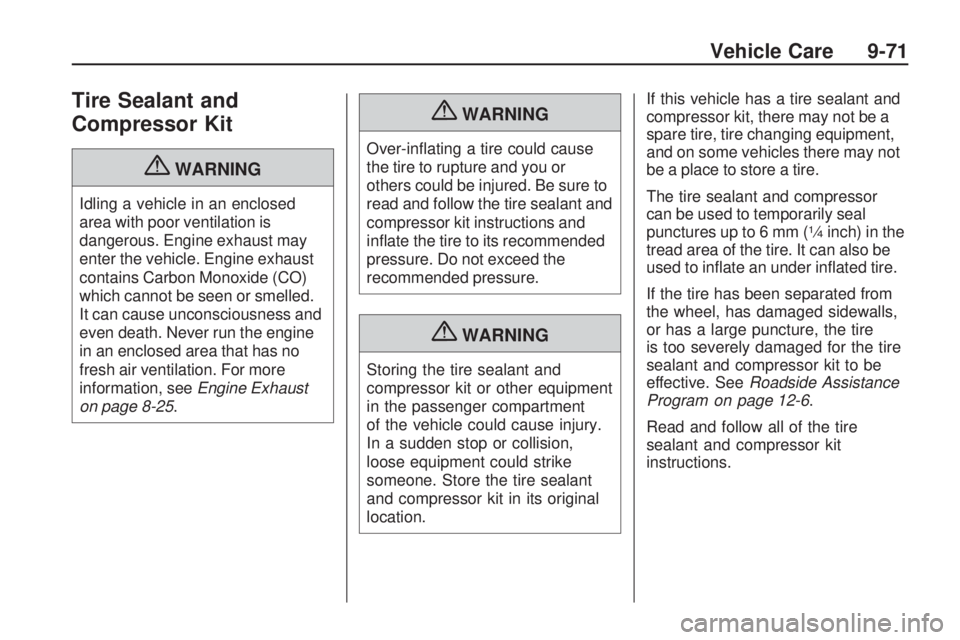
Tire Sealant and
Compressor Kit
{WARNING
Idling a vehicle in an enclosed
area with poor ventilation is
dangerous. Engine exhaust may
enter the vehicle. Engine exhaust
contains Carbon Monoxide (CO)
which cannot be seen or smelled.
It can cause unconsciousness and
even death. Never run the engine
in an enclosed area that has no
fresh air ventilation. For more
information, seeEngine Exhaust
on page 8-25.
{WARNING
Over-inflating a tire could cause
the tire to rupture and you or
others could be injured. Be sure to
read and follow the tire sealant and
compressor kit instructions and
inflate the tire to its recommended
pressure. Do not exceed the
recommended pressure.
{WARNING
Storing the tire sealant and
compressor kit or other equipment
in the passenger compartment
of the vehicle could cause injury.
In a sudden stop or collision,
loose equipment could strike
someone. Store the tire sealant
and compressor kit in its original
location.If this vehicle has a tire sealant and
compressor kit, there may not be a
spare tire, tire changing equipment,
and on some vehicles there may not
be a place to store a tire.
The tire sealant and compressor
can be used to temporarily seal
punctures up to 6 mm (
1⁄4inch) in the
tread area of the tire. It can also be
used to inflate an under inflated tire.
If the tire has been separated from
the wheel, has damaged sidewalls,
or has a large puncture, the tire
is too severely damaged for the tire
sealant and compressor kit to be
effective. SeeRoadside Assistance
Program on page 12-6.
Read and follow all of the tire
sealant and compressor kit
instructions.
Vehicle Care 9-71
Page 304 of 372
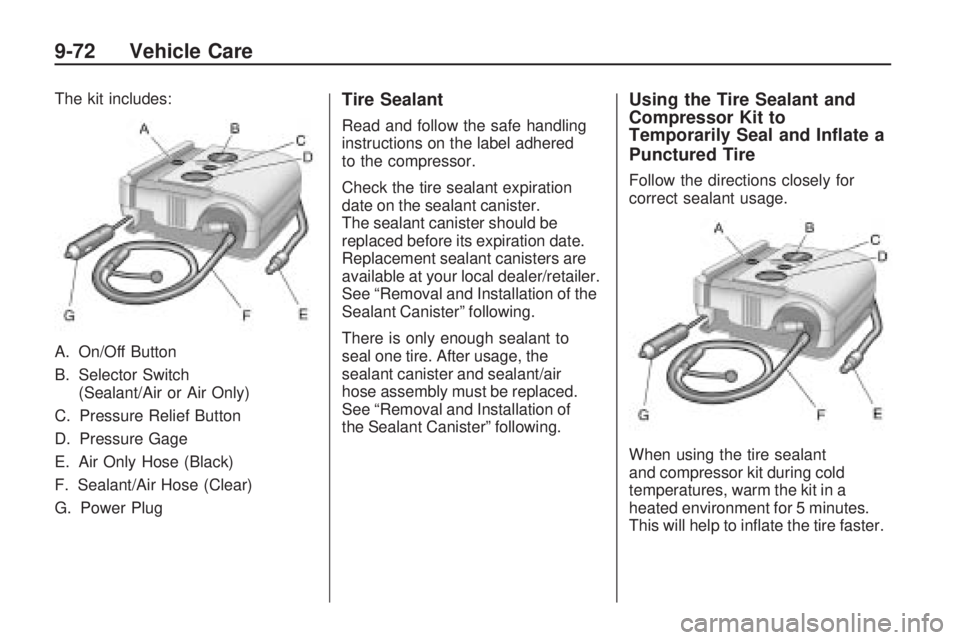
The kit includes:
A. On/Off Button
B. Selector Switch
(Sealant/Air or Air Only)
C. Pressure Relief Button
D. Pressure Gage
E. Air Only Hose (Black)
F. Sealant/Air Hose (Clear)
G. Power PlugTire Sealant
Read and follow the safe handling
instructions on the label adhered
to the compressor.
Check the tire sealant expiration
date on the sealant canister.
The sealant canister should be
replaced before its expiration date.
Replacement sealant canisters are
available at your local dealer/retailer.
See “Removal and Installation of the
Sealant Canister” following.
There is only enough sealant to
seal one tire. After usage, the
sealant canister and sealant/air
hose assembly must be replaced.
See “Removal and Installation of
the Sealant Canister” following.
Using the Tire Sealant and
Compressor Kit to
Temporarily Seal and In�ate a
Punctured Tire
Follow the directions closely for
correct sealant usage.
When using the tire sealant
and compressor kit during cold
temperatures, warm the kit in a
heated environment for 5 minutes.
This will help to inflate the tire faster.
9-72 Vehicle Care
Page 305 of 372
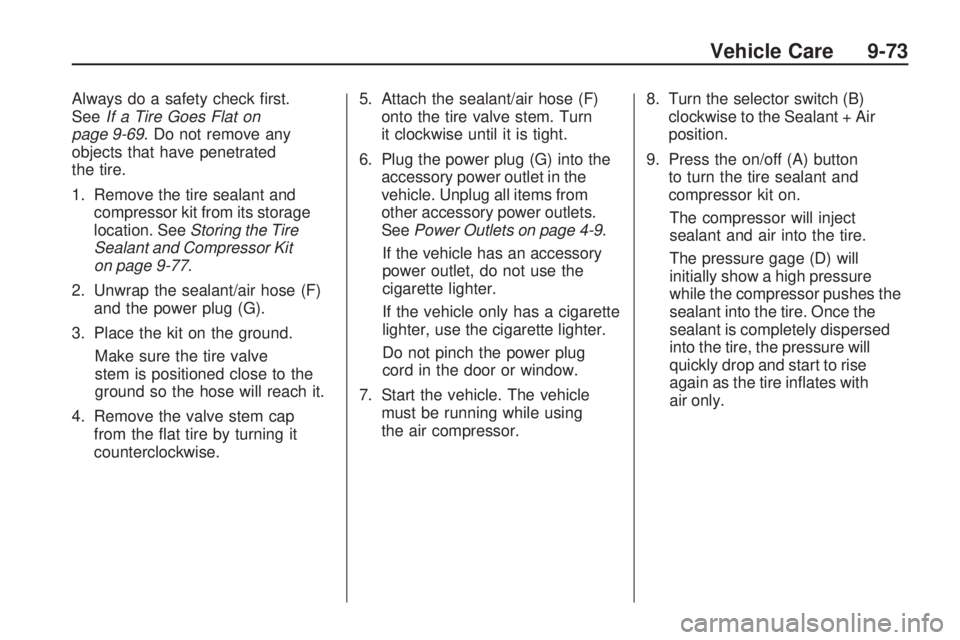
Always do a safety check first.
SeeIf a Tire Goes Flat on
page 9-69. Do not remove any
objects that have penetrated
the tire.
1. Remove the tire sealant and
compressor kit from its storage
location. SeeStoring the Tire
Sealant and Compressor Kit
on page 9-77.
2. Unwrap the sealant/air hose (F)
and the power plug (G).
3. Place the kit on the ground.
Make sure the tire valve
stem is positioned close to the
ground so the hose will reach it.
4. Remove the valve stem cap
from the flat tire by turning it
counterclockwise.5. Attach the sealant/air hose (F)
onto the tire valve stem. Turn
it clockwise until it is tight.
6. Plug the power plug (G) into the
accessory power outlet in the
vehicle. Unplug all items from
other accessory power outlets.
SeePower Outlets on page 4-9.
If the vehicle has an accessory
power outlet, do not use the
cigarette lighter.
If the vehicle only has a cigarette
lighter, use the cigarette lighter.
Do not pinch the power plug
cord in the door or window.
7. Start the vehicle. The vehicle
must be running while using
the air compressor.8. Turn the selector switch (B)
clockwise to the Sealant + Air
position.
9. Press the on/off (A) button
to turn the tire sealant and
compressor kit on.
The compressor will inject
sealant and air into the tire.
The pressure gage (D) will
initially show a high pressure
while the compressor pushes the
sealant into the tire. Once the
sealant is completely dispersed
into the tire, the pressure will
quickly drop and start to rise
again as the tire inflates with
air only.
Vehicle Care 9-73
Page 306 of 372
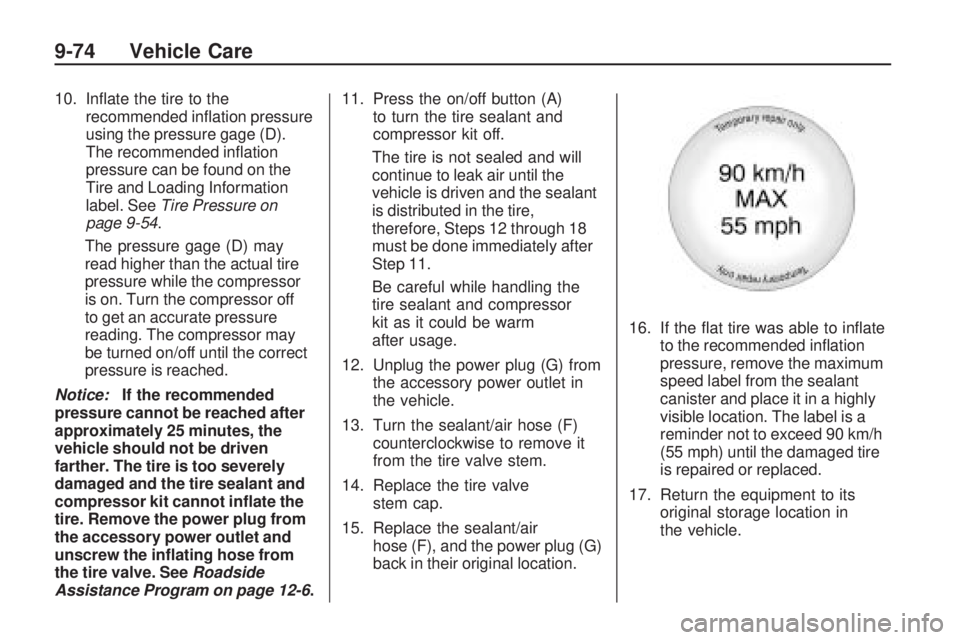
10. Inflate the tire to the
recommended inflation pressure
using the pressure gage (D).
The recommended inflation
pressure can be found on the
Tire and Loading Information
label. SeeTire Pressure on
page 9-54.
The pressure gage (D) may
read higher than the actual tire
pressure while the compressor
is on. Turn the compressor off
to get an accurate pressure
reading. The compressor may
be turned on/off until the correct
pressure is reached.
Notice:If the recommended
pressure cannot be reached after
approximately 25 minutes, the
vehicle should not be driven
farther. The tire is too severely
damaged and the tire sealant and
compressor kit cannot in�ate the
tire. Remove the power plug from
the accessory power outlet and
unscrew the in�ating hose from
the tire valve. SeeRoadside
Assistance Program on page 12-6.11. Press the on/off button (A)
to turn the tire sealant and
compressor kit off.
The tire is not sealed and will
continue to leak air until the
vehicle is driven and the sealant
is distributed in the tire,
therefore, Steps 12 through 18
must be done immediately after
Step 11.
Be careful while handling the
tire sealant and compressor
kit as it could be warm
after usage.
12. Unplug the power plug (G) from
the accessory power outlet in
the vehicle.
13. Turn the sealant/air hose (F)
counterclockwise to remove it
from the tire valve stem.
14. Replace the tire valve
stem cap.
15. Replace the sealant/air
hose (F), and the power plug (G)
back in their original location.16. If the flat tire was able to inflate
to the recommended inflation
pressure, remove the maximum
speed label from the sealant
canister and place it in a highly
visible location. The label is a
reminder not to exceed 90 km/h
(55 mph) until the damaged tire
is repaired or replaced.
17. Return the equipment to its
original storage location in
the vehicle.
9-74 Vehicle Care
Page 307 of 372
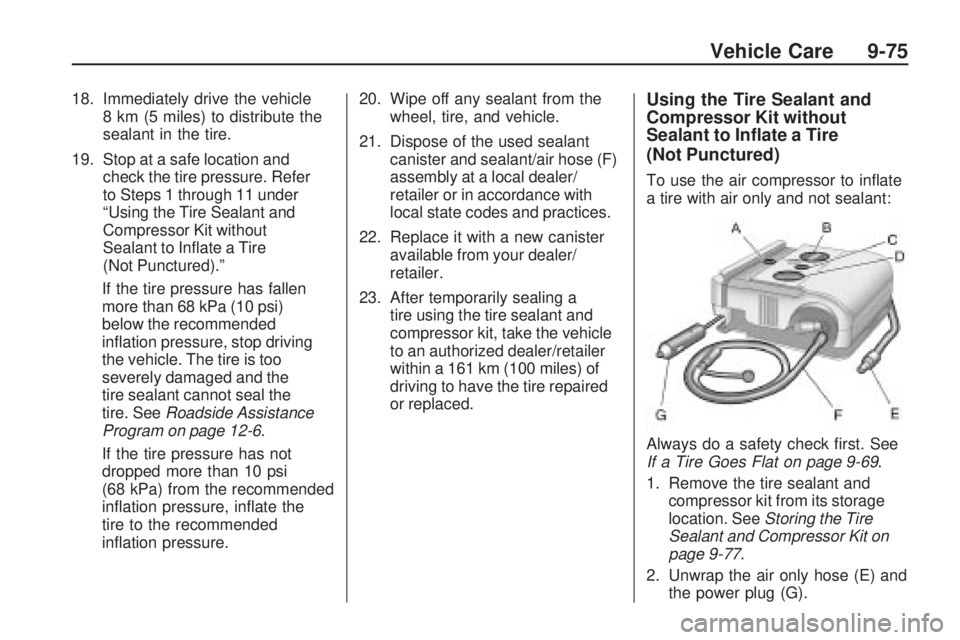
18. Immediately drive the vehicle
8 km (5 miles) to distribute the
sealant in the tire.
19. Stop at a safe location and
check the tire pressure. Refer
to Steps 1 through 11 under
“Using the Tire Sealant and
Compressor Kit without
Sealant to Inflate a Tire
(Not Punctured).”
If the tire pressure has fallen
more than 68 kPa (10 psi)
below the recommended
inflation pressure, stop driving
the vehicle. The tire is too
severely damaged and the
tire sealant cannot seal the
tire. SeeRoadside Assistance
Program on page 12-6.
If the tire pressure has not
dropped more than 10 psi
(68 kPa) from the recommended
inflation pressure, inflate the
tire to the recommended
inflation pressure.20. Wipe off any sealant from the
wheel, tire, and vehicle.
21. Dispose of the used sealant
canister and sealant/air hose (F)
assembly at a local dealer/
retailer or in accordance with
local state codes and practices.
22. Replace it with a new canister
available from your dealer/
retailer.
23. After temporarily sealing a
tire using the tire sealant and
compressor kit, take the vehicle
to an authorized dealer/retailer
within a 161 km (100 miles) of
driving to have the tire repaired
or replaced.Using the Tire Sealant and
Compressor Kit without
Sealant to In�ate a Tire
(Not Punctured)
To use the air compressor to inflate
a tire with air only and not sealant:
Always do a safety check first. See
If a Tire Goes Flat on page 9-69.
1. Remove the tire sealant and
compressor kit from its storage
location. SeeStoring the Tire
Sealant and Compressor Kit on
page 9-77.
2. Unwrap the air only hose (E) and
the power plug (G).
Vehicle Care 9-75
Page 308 of 372
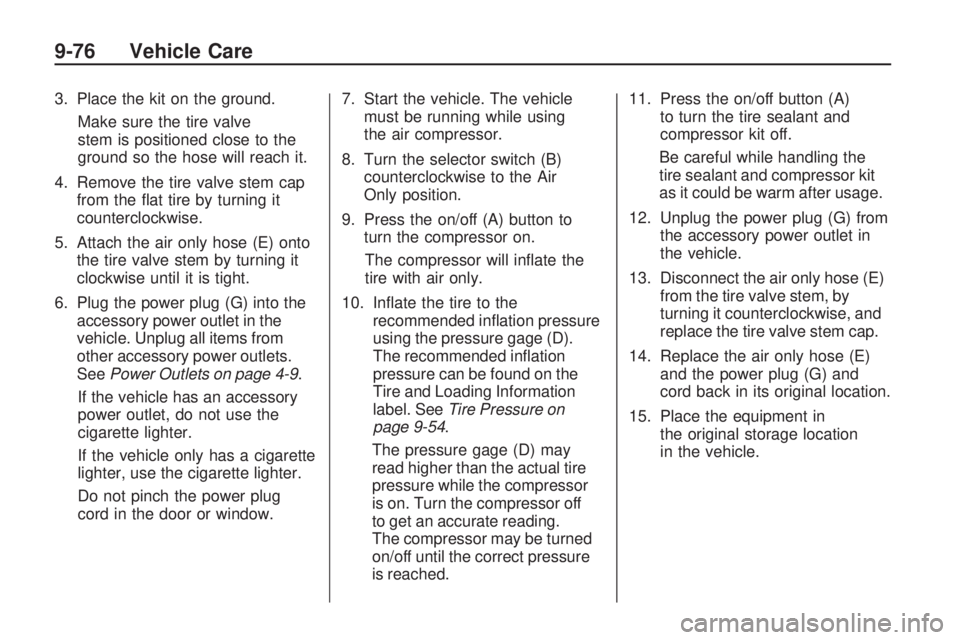
3. Place the kit on the ground.
Make sure the tire valve
stem is positioned close to the
ground so the hose will reach it.
4. Remove the tire valve stem cap
from the flat tire by turning it
counterclockwise.
5. Attach the air only hose (E) onto
the tire valve stem by turning it
clockwise until it is tight.
6. Plug the power plug (G) into the
accessory power outlet in the
vehicle. Unplug all items from
other accessory power outlets.
SeePower Outlets on page 4-9.
If the vehicle has an accessory
power outlet, do not use the
cigarette lighter.
If the vehicle only has a cigarette
lighter, use the cigarette lighter.
Do not pinch the power plug
cord in the door or window.7. Start the vehicle. The vehicle
must be running while using
the air compressor.
8. Turn the selector switch (B)
counterclockwise to the Air
Only position.
9. Press the on/off (A) button to
turn the compressor on.
The compressor will inflate the
tire with air only.
10. Inflate the tire to the
recommended inflation pressure
using the pressure gage (D).
The recommended inflation
pressure can be found on the
Tire and Loading Information
label. SeeTire Pressure on
page 9-54.
The pressure gage (D) may
read higher than the actual tire
pressure while the compressor
is on. Turn the compressor off
to get an accurate reading.
The compressor may be turned
on/off until the correct pressure
is reached.11. Press the on/off button (A)
to turn the tire sealant and
compressor kit off.
Be careful while handling the
tire sealant and compressor kit
as it could be warm after usage.
12. Unplug the power plug (G) from
the accessory power outlet in
the vehicle.
13. Disconnect the air only hose (E)
from the tire valve stem, by
turning it counterclockwise, and
replace the tire valve stem cap.
14. Replace the air only hose (E)
and the power plug (G) and
cord back in its original location.
15. Place the equipment in
the original storage location
in the vehicle.
9-76 Vehicle Care
Page 309 of 372
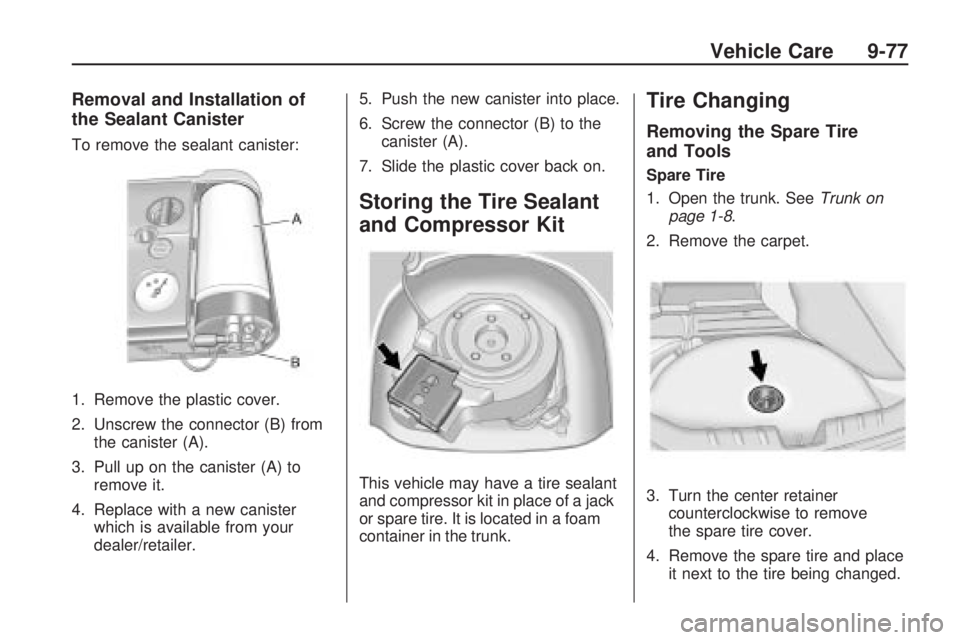
Removal and Installation of
the Sealant Canister
To remove the sealant canister:
1. Remove the plastic cover.
2. Unscrew the connector (B) from
the canister (A).
3. Pull up on the canister (A) to
remove it.
4. Replace with a new canister
which is available from your
dealer/retailer.5. Push the new canister into place.
6. Screw the connector (B) to the
canister (A).
7. Slide the plastic cover back on.
Storing the Tire Sealant
and Compressor Kit
This vehicle may have a tire sealant
and compressor kit in place of a jack
or spare tire. It is located in a foam
container in the trunk.
Tire Changing
Removing the Spare Tire
and Tools
Spare Tire
1. Open the trunk. SeeTrunk on
page 1-8.
2. Remove the carpet.
3. Turn the center retainer
counterclockwise to remove
the spare tire cover.
4. Remove the spare tire and place
it next to the tire being changed.
Vehicle Care 9-77
Page 310 of 372
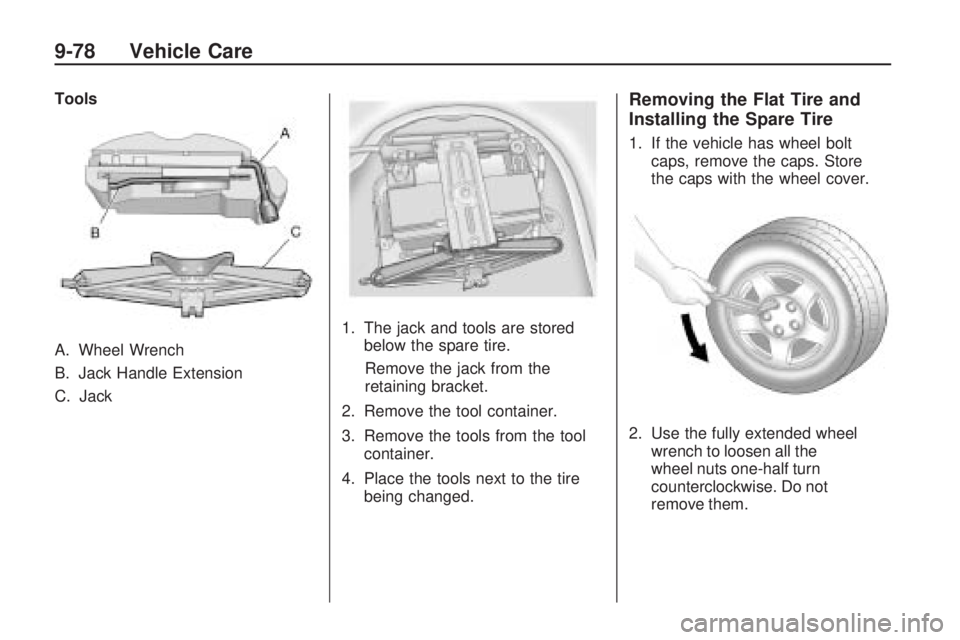
Tools
A. Wheel Wrench
B. Jack Handle Extension
C. Jack1. The jack and tools are stored
below the spare tire.
Remove the jack from the
retaining bracket.
2. Remove the tool container.
3. Remove the tools from the tool
container.
4. Place the tools next to the tire
being changed.Removing the Flat Tire and
Installing the Spare Tire
1. If the vehicle has wheel bolt
caps, remove the caps. Store
the caps with the wheel cover.
2. Use the fully extended wheel
wrench to loosen all the
wheel nuts one-half turn
counterclockwise. Do not
remove them.
9-78 Vehicle Care